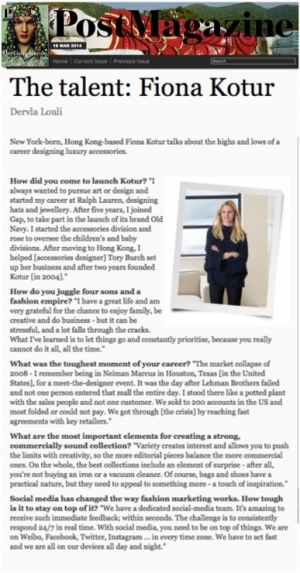New York-born, Hong Kong-based Fiona Kotur talks about the highs and lows of a career designing luxury accessories.
How did you come to launch Kotur? “I always wanted to pursue art or design and started my career at Ralph Lauren, designing hats and jewellery. After five years, I joined Gap, to take part in the launch of its brand Old Navy. I started the accessories division and rose to oversee the children’s and baby divisions. After moving to Hong Kong, I helped [accessories designer] Tory Burch set up her business and after two years founded Kotur [in 2004].”
How do you juggle four sons and a fashion empire? “I have a great life and am very grateful for the chance to enjoy family, be creative and do business – but it can be stressful, and a lot falls through the cracks. What I’ve learned is to let things go and constantly prioritise, because you really cannot do it all, all the time.”
What was the toughest moment of your career? “The market collapse of 2008 – I remember being in Neiman Marcus in Houston, Texas [in the United States], for a meet-the-designer event. It was the day after Lehman Brothers failed and not one person entered that mall the entire day. I stood there like a potted plant with the sales people and not one customer. We sold to 200 accounts in the US and most folded or could not pay. We got through [the crisis] by reaching fast agreements with key retailers.”
What are the most important elements for creating a strong, commercially sound collection? “Variety creates interest and allows you to push the limits with creativity, so the more editorial pieces balance the more commercial ones. On the whole, the best collections include an element of surprise – after all, you’re not buying an iron or a vacuum cleaner. Of course, bags and shoes have a practical nature, but they need to appeal to something more – a touch of inspiration.”
Social media has changed the way fashion marketing works. How tough is it to stay on top of it? “We have a dedicated social-media team. It’s amazing to receive such immediate feedback; within seconds. The challenge is to consistently respond 24/7 in real time. With social media, you need to be on top of things. We are on Weibo, Facebook, Twitter, Instagram … in every time zone. We have to act fast and we are all on our devices all day and night.”
